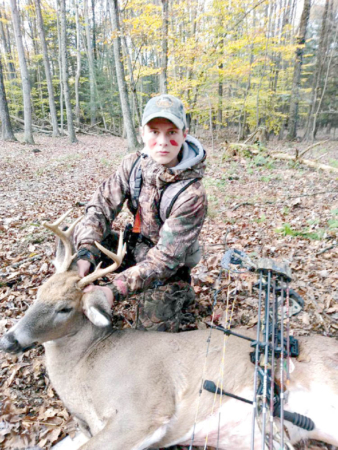When we think about calling in a game animal, we usually associate that idea with calling in a turkey or maybe even a coyote; but as many archery hunters know, calling can also be very effective when hunting during the rut. The rut will go through three phases as we head into late October and into November; the “seeking phase’, the “chasing phase,” and the “breeding phase.” As all seasoned archery hunters know, it is this fall breeding season that brings on the rubs and scraps that assist us in locating stands to ambush our buck. Picking the right location to hunt is important, but it might also be a good idea to have calls on hand when you head up on stand since bucks will often respond to a call at this point in the season.
When referring to deer calls, there are basically two types bow-hunters use — antlers and various types of tubes to mimic different vocalizations. Rattling, which is the interaction of two deer antlers coming together to mimic bucks in combat, can be effective, especially if more mature bucks are in the area. I’ve not done a lot of rattling, but those who have had success, suggest that you make your rattling short, loud, and aggressive sounding. Maybe rattle for a minute, pause for a minute or so and then rattle again for a brief period.
While rattling may be effective at times, I suspect that calling with a grunt tube is the more popular choice of calling techniques and quite possibly the more effective call. Researchers have determined that deer make over 200 different sounds, but when it comes to calling in a deer, only a few calls are really necessary-bleats, fawn bleats, and the grunt; the grunt is probably the most effective to lull that breeding buck.
Deer make several different types of grunt sounds, and they often vary in tone; for example, older bucks have more base in their grunt, or they are more guttural. Probably one of the most effective grunts is the trailing grunt; it’s a short grunt that bucks make as they move through the woods and around other deer. This is a good call if you see a buck walking through and you need to bring him closer for a shot, but it can also be effective when no deer are in sight. The first time I ever used this call, I saw a buck walking by out of bow range, but a quick grunt turned the deer, and he immediately walked to within bow range.
When we went to our son’s house last week to see the nice eight-point buck our grandson shot with his compound bow, I was reminded of the buck that responded to my grunt call years ago. The buck was walking by when Gavin made a brief grunt call, and the buck immediately came toward him, presenting him with the shot he needed; the arrow pierced the spinal cord and dropped the buck. This was his first buck ever with a bow. Had he not utilized that grunt call, it’s very likely that buck would have passed right on by. It’s also important to note that using these types of calls does not require years of practice to become proficient.
While it’s no guarantee, I have made it a point to never climb into my bow hunting tree stand without my grunt tube, and you can bet that my grandson, Gavin, will always have his on hand as well.





Leave a Comment
Your email address will not be published. Required fields are marked with *